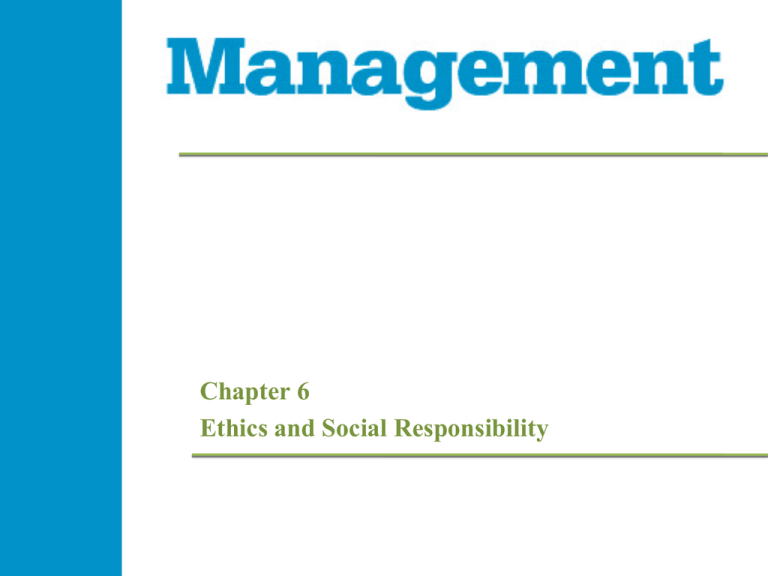
Chapter 6
Ethics and Social Responsibility
Learning Objectives
Explain ethics as they relate to the five domains of
individuals, organizations, stakeholders, government, and
the global community
Demonstrate processes and practices for managing
organizational ethics
Describe how businesses approach social responsibility
Explain how organizations seek to prosper through social
responsibility
Summarize management’s role in building responsible
businesses based on ethical decision making
Management 1e
6-2
What Are Ethics? (p. 144)
Ethics
• The moral principles, values, and beliefs that
govern group or individual behavior according to
what is right or wrong and what contributes to the
balanced good of all stakeholders
• Ethical dilemma – a situation in which no choice
is entirely right
Management 1e
6-3
What Are Ethics? (cont.)
Domains of ethical decision making
Figure 6.1
Management 1e
6-4
What Are Ethics? (cont.)
Individuals (p. 145)
• Lawrence Kohlberg’s “stages of moral development”
Progression from interests in self to interest in others (p.
146)
Preconventional – moral decisions are based primarily on
self-protection or self-interest
Conventional – moral decisions are based primarily on
social norms
• Societal norms – expectations about how people (and
organizations) should behave
Postconventional – moral decisions are based primarily on
what individual believes is good for society as a whole
Management 1e
6-5
What Are Ethics? (cont.)
Kohlberg’s stages of moral development
Figure 6.2
Management 1e
6-6
What Are Ethics? (cont.)
Organizations - posture of the organization
toward the local and global communities (p. 146)
Figure 6.3
Management 1e
6-7
What Are Ethics? (cont.)
Value-based management - company’s culture impacts
employee behavior in ways that are
consistent with the
organization’s mission
and values (p. 147)
Figure 6.4
Management 1e
6-8
What Are Ethics? (cont.)
Stakeholders (p. 148)
• Internal and external constituents with a direct interest
in the organization’s behavior
Experience the effects of company’s management decisions
Figure 6.5
Management 1e
6-9
What Are Ethics? (cont.)
CRITICAL
THINKING
Externality – a cost (negative) or benefit (positive) that
occurs beyond the direct exchange between an
organization and its stakeholders (p. 148)
Escalation – an increase in an organization’s behavior
as a direct response to a competitor’s behavior (p. 149)
Management 1e
6 - 10
What Are Ethics? (cont.)
Governments (p. 149)
• Enact legal requirements to prevent unethical
behavior
E.g., Sarbannes-Oxley Act (2002) – requires greater
transparency in company accounting practices
• Face “fundamental large-firm problem” stemming
from:
Separation of ownership and control
Decentralized regulation system
Management 1e
6 - 11
What Are Ethics? (cont.)
Globe (p. 150)
• Global-level of ethics – principles, values, and
beliefs that are widely considered universal
United Nations’ - “The Global Compact”
• Intended to guide decision making in the areas of human
rights, labor, the environment, and anti-corruption
Management 1e
6 - 12
Making Ethical Decisions (p. 151)
Principles of ethics (p. 152)
• Legal principle – decisions that follow both the
letter and spirit of the law
• Individual rights principle – decisions that do not
infringe upon the rights of other people
• Virtuous principle – decisions of which you would
be publicly proud
• Long-term principle – decisions that support the
long-term interests of yourself and your
organization
Management 1e
6 - 13
Making Ethical Decisions (cont.)
Principles of ethics (cont.)
• Community principle – decisions that contribute to
the strength and well-being of the community (p.
152)
• Utilitarian principle – decisions that provide the
greatest good to the greatest number (or the least
harm to the fewest number)
• Distributed justice principle – decisions that do not
harm those who already are disadvantaged
Management 1e
6 - 14
Making Ethical Decisions (cont.)
Codes of conduct - organization’s published guidelines
of its expectations about ethical behavior (p. 153)
• Typically address conduct in eight areas
Fiduciary
Dignity
Property
Transparency
Reliability
Fairness
Citizenship
Responsiveness
Management 1e
6 - 15
Making Ethical Decisions (cont.)
Principle-based management (p. 153)
• Organization proactively connects values and
beliefs to behavior expectations
• All stakeholders are continuously made aware of
standards for behavior
• Stakeholders become a vital component to decision
making
Management 1e
6 - 16
Social Responsibility (p. 154)
Social responsibility (p. 155)
• Proactive behaviors for the benefit of society
Corporate social responsibility (CSR)
• Programs that coordinate the company’s efforts to
address societal and community challenges as they
emerge
Management 1e
6 - 17
Social Responsibility (cont.)
Approaches to social responsibility (p. 155)
• Proactive approach – organization goes beyond
industry norms to solve and prevent problems
Begin by consulting the articles of incorporation
May change the legal structure to support socially
responsible activities
• B Lab – non-profit organization that certifies socially
responsible companies
• Accommodative approach – organization accepts
responsibility and takes action in response to
societal pressures (p. 156)
Management 1e
6 - 18
Social Responsibility (cont.)
Approaches to social responsibility (cont.)
• Defensive approach – organization accepts
responsibility, but does only the minimum required
(p. 156)
• Reactive approach – organization denies
responsibility for social problems and responds
only when legally required
Management 1e
6 - 19
How Does Social Responsibility Pay?
(p. 157)
Social entrepreneurs - people who start a business for
the dual purpose of profits and societal benefits
• Consumers and investors becoming more active in
supporting and investing in socially responsible
companies
• Social investing – e.g., Calvert Social Investment Fund
screens companies on financial performance and:
Environment
Workplace
Human rights
Indigenous peoples’ rights
Community relations
Product safety and impact
Governance business ethics
Management 1e
6 - 20
Managing Social Responsibility Today
(p. 158)
Managers must make principle-based
decisions informed by industry and societal
standards
• Internalizing an externality – management
proactively addresses a negative externality for the
benefit of its stakeholders
• Building an ethical culture
Apply a framework for ethical decision making
Ethics training
Management 1e
6 - 21
Managing Social Responsibility Today
(cont.)
Ethical decision making framework (p. 158)
• Duties (p. 159)
Perfect duties – clearly articulated moral obligations
Imperfect duties – moral obligations that can be
interpreted in different ways
• Rights –behaviors that can be expected from others,
based on their duties
• Standards of excellence – organization’s highest
expectations of behavior
• Commitments – self-defined principles unique to an
individual or organization
Management 1e
6 - 22
Managing Social Responsibility Today
(cont.)
Ethical decision making framework (cont.)
• Applying the framework (p. 159)
Understanding the situation
Connecting behaviors to standards
Impartial analysis
• Visibility – the “newspaper test”
• Generality – would all organizational members be comfortable
with action taken
• Legacy – would decision maker be comfortable being
remembered for the action taken
Management 1e
6 - 23
Managing Social Responsibility Today
(cont.)
Ethics training (p. 159)
• Intended to prevent unethical behavior from occurring
Figure 6.6
Management 1e
6 - 24
Managing Social Responsibility Today
(cont.)
Ethics training (cont.)
• Audience for training
Training characteristics – trainees’ current moral profile
• Audience’s assertiveness, cognitive ability, perspective on ethical
behavior (p. 159)
Needs assessment – determine audience’s need for ethics
training (p. 160)
Training transfer – steps to assure that what is learned
about ethics will be used on the job
Evaluation – determine the effect of training on trainees’:
Reaction to the training
Knowledge/skills tests
Management 1e
Workplace behavior
Organizational performance
6 - 25
Managing Social Responsibility Today
(cont.)
In the interests of
self or others?
(p. 161)
Tragedy of
the commons
Figure 6.7
Management 1e
6 - 26
Copyright
Copyright © 2014 John Wiley & Sons, Inc.
All rights reserved. Reproduction or translation of this work
beyond that permitted in Section 117 of the 1976 United States
Copyright Act without express permission of the copyright owner
is unlawful. Request for further information should be addressed
to the Permissions Department, John Wiley & Sons, Inc. The
purchaser may make back-up copies for his/her own use only and
not for distribution or resale. The Publisher assumes no
responsibility for errors, omissions, or damages, caused by the
use of these programs or from the use of the information herein.
Management 1e
6 - 27






